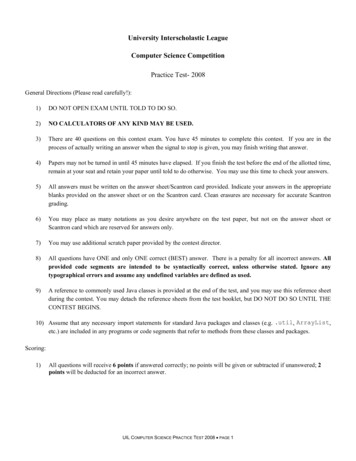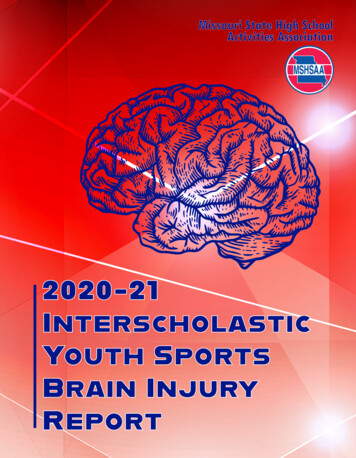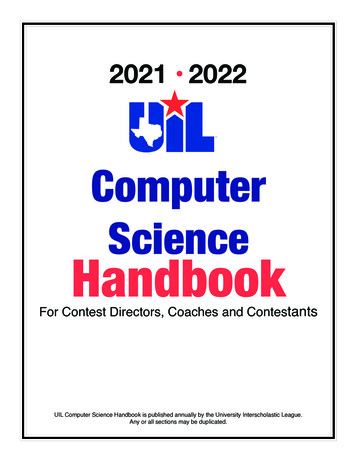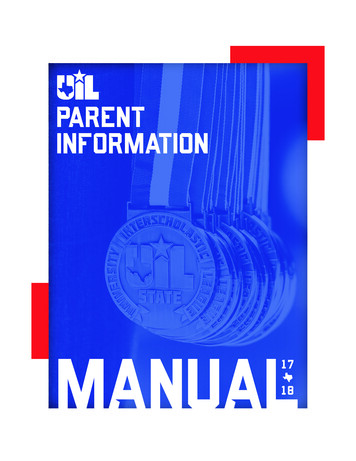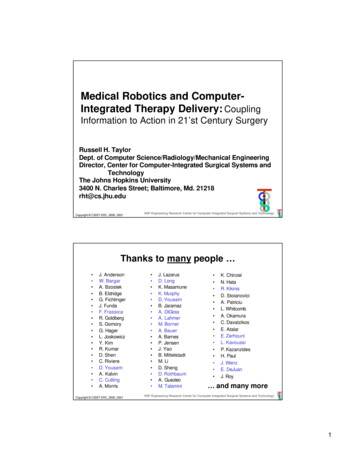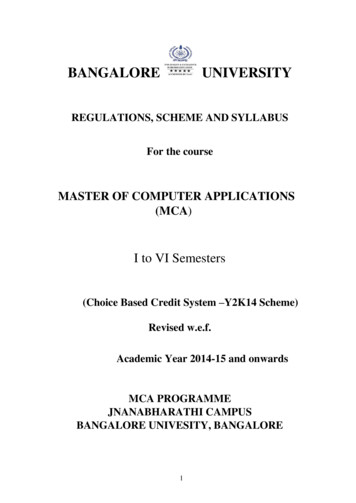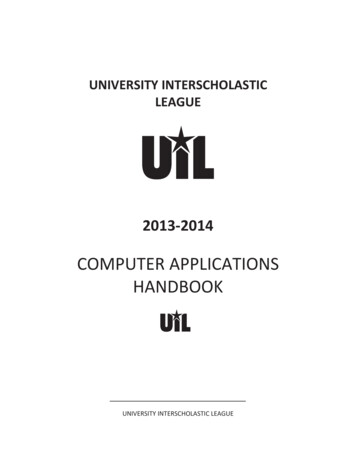
Transcription
UNIVERSITY INTERSCHOLASTICLEAGUE2013Ͳ2014COMPUTER APPLICATIONSHANDBOOKUNIVERSITY INTERSCHOLASTIC LEAGUE
MAKING A WORLD OF DIFFERENCEContact InformationOn most Saturdays while you're grading invitational tests, I'm available in my office (830.367.3825),or the phone message will direct you to my cell phone. If you hit a roadblock in your grading andwant a mediator, don't hesitate to call. The goals of the tests are as follows:1. Have a level playing field.2. Have a level of difficulty so that the top places are earned, not just decided with atiebreaker.3. Enable the students to become very, very competent in this powerful package. I'm also available during the week at the same number or by email: hexco@hexco.com. This is yourcontest. We listen to all the input from both the competitors and the coaches. We want to weldthis into the best possible contest. Let's work together to make this a positive experience as wemove through this transition. Linda Tarrant, Contest Director Computer Applications HandbookWritten & edited by Linda TarrantPlease contact us with any questions, suggestions, problems, or comments on the book.HEXCO ACADEMIC. PO Box 199 Hunt, TX 78024 Info: (830) 367Ͳ3825 Fax (830) 367Ͳ3824 email: hexco@hexco.comwww.hexco.comUNIVERSITY INTERSCHOLASTIC LEAGUEMAKING A WORLD OF DIFFERENCEPlease contact UIL for additional copies of the Handbook. Box 8028 Ͳ University StationAustin, TX 78713Ͳ8028) (512) 471Ͳ5883 ademics
What to Expect for 2013Ͳ2014U Use a "current or near current version of Microsoft Office" Again, for the 2013Ͳ2014 school year, we will write and take all tests in Microsoft Office 2007 or 2010. If schools areusing Microsoft Office 2013, we will also take tests in this version. No versions older than Office 2007 will be acceptablefor this contest. The word processing element must be done in Word; spreadsheet elements, in Excel; and databaseelements, in Access. Graders may check saved devices to ascertain that the appropriate element of a test was donein the appropriate application package (i.e. if a database element was executed entirely in Excel, it should not begraded). However, some students may choose to start in Excel, manipulate calculations, and then take the output ofthe spreadsheet to Access to complete processing. This is acceptable unless a test specifically asks that formulas fromAccess be printed. In this case, Excel formulas will not be accepted. Be sure that all features are installed in all theMicrosoft applications, and that they are updated.U Downloadable Lesson Plans on the UIL website To integrate more of the parts of the Computer Application Contest into your classrooms, UIL has five separate LessonPlans that are downloadable from their website: ations. Topics covered include the following:Lesson 4ͲField Codes for TextͲDateͲTimeLesson 1ͲSimplifying the IFLesson 5ͲField Codes for NumbersLesson 2ͲDate & TimeLesson 3ͲUpdate Queries and the Expression BuilderU Frequently Asked Questions on the UIL website To provide support to coaches for this contest, we added frequently asked questions recently, and these have extensiveexplanations at http://www.uiltexas.org/files/academics/ComApps FAQ.pdf for the following questions.When do graders look at a student's flash drive?Why should students participate in UIL?Where are the contest rules posted?How do my students earn better scores?Can I teach contestants in the classroom?If I have questions, who do I contact?Where do I find practice materials?. and moreWhat happens at an invitational meet?U Constitution & Contest Rules The following changes have been included in the C&CR in recent years. " Coaches and participants are responsible for contest information in the Computer Applications Handbook,which is published annually and available through UIL. " A current or near current version of Microsoft Office is specified for use, and the specific versions to be usedare identified in the annual Computer Applications Handbook." A contestant may be disqualified if a coach does not grade.U Computer Application Handbook This Computer Applications Handbook contains an expansion of rules for participation in the Computer ApplicationsContest, instructions for conducting a contest, and data specific to this contest. Participants are expected to know allthe information in this handbook. Our intent is to simplify and organize the amount of information required to bememorized from the Keyboarding Quick Reference Guide, which is still a valid reference.Student should make templates of each of the document formats, should know how a contest is conducted, and shouldknow how to handle a system or printer malfunction in a contest. Students should be able to use all functions for Office 2007. They need not understand how PMT, COS, ATAN, STD, etc.work, but they should be able to use any function. Function names are not all the same in Access and Excel.
U Using Downloadable Files The Region and State Meet used large downloaded files for the test. Coaches and students were instructed todownload the files from the UIL website prior to the meet, and a flash drive was available at the meet to copy files tostudents' computers for those who had not done so. There were multiple tables in the downloaded file with a largenumber of records. The process worked well, and the grading was more rapid than usual. The 2014 Region and StateMeets will use a downloadable file that will be posted in January on the UIL website.The current file that was downloaded had multiple tables. No test will use all the available tables, but they will definewhich tables are to be used for a given test.U State Meet SurveyThe survey distributed to coaches and competitors at the State Meet had the following questions, and the resultsare explained. There were 28 coaches and 30 competitors who submitted surveys, which is about half of theparticipants and/or their coaches.How did grading go at your competitions this year? (These were similar to last year's results.) 32% Ͳ Great61% Ͳ Better7% Ͳ Awful Did the difficulty level of the tests progress at an acceptable rate? (These were similar to last year's results.)Inv A & B24% "Too Easy"75% "Okay"one person checked "Too Hard"Dist 1 & 211% "Too Easy"82% "Okay"8% "Too Hard"Region6% "Too Easy"89% "Okay"5% "Too Hard"Did you have any problems downloading or using the downloaded files at Region? Only one reported problem.Some didn't know ahead of time, but installed file at the region site. What is your opinion of the use of downloaded files? Positive: Most comments were very positive about reducedtypos, ease of grading, more like a realͲworld application, more focus on the power of the programs.Negative: Students should have to create tables; fast typists no longer have advantage.What version of Office is used? 2007 Ͳ 44% 2010 Ͳ 53% 2013 Ͳ 3%What do you wish we would cover in the fall Student Activities Conferences (SAC)?Pivot tablesGrading explanation/exampleFormatting a reportWordͲmerge formattingShortcutsLookup in Excel from Access file Prior year's State testCalculated fields in reportsInstructions on taking a testMore AccessQueries in AccessWhat do you wish we were doing differently?More training on websiteDownloaded files before RegionWider variety of layouts/formatsMore practice with download fileEmbedded tablesFewer examplesNo points for default itemsFewer stepͲbyͲstep instructionsWhat are your other concerns? Document formats antiquatedCreate database downloadsLeave last year's files on webSupply flashdrives for downloadLess time for setupComputerized gradingSQL and VBA types of skillsWatch for blueͲtooth/wirelesscapabilitiesThanks to all who took the time to submit surveys! We read every one, we analyze, and we continue to makechanges to improve this contest. Students, remember, this contest belongs to you, not to me, not to your coach. If you have ideas, let me know. Linda Tarrant, Contest Director linda@hexco.com
Table of ContentsI.Commentary on the Constitution . . . . . . . . . . . . . . . . . . . . . . . . . . . . . . . . . . . . . . . . . . . . . . . . . . . 2II.Computer Applications Tests . . . . . . . . . . . . . . . . . . . . . . . . . . . . . . . . . . . . . . . . . . . . . . . . . . . . . . . 2III.Software . . . . . . . . . . . . . . . . . . . . . . . . . . . . . . . . . . . . . . . . . . . . . . . . . . . . . . . . . . . . . . . . . . . . . . . . 2IV.Optional Material . . . . . . . . . . . . . . . . . . . . . . . . . . . . . . . . . . . . . . . . . . . . . . . . . . . . . . . . . . . . . . . . . 2V.Equipment . . . . . . . . . . . . . . . . . . . . . . . . . . . . . . . . . . . . . . . . . . . . . . . . . . . . . . . . . . . . . . . . . . . . . . . 3VI.Equipment Malfunction during a Contest . . . . . . . . . . . . . . . . . . . . . . . . . . . . . . . . . . . . . . . . . . . . . 3VII.Conducting a Contest . . . . . . . . . . . . . . . . . . . . . . . . . . . . . . . . . . . . . . . . . . . . . . . . . . . . . . . . . . . . . . 4VIII.Grading Procedures . . . . . . . . . . . . . . . . . . . . . . . . . . . . . . . . . . . . . . . . . . . . . . . . . . . . . . . . . . . . . . . 4IX.Verification Period . . . . . . . . . . . . . . . . . . . . . . . . . . . . . . . . . . . . . . . . . . . . . . . . . . . . . . . . . . . . . . . . 5X.Reports . . . . . . . . . . . . . . . . . . . . . . . . . . . . . . . . . . . . . . . . . . . . . . . . . . . . . . . . . . . . . . . . . . . . . . . . . 6XI.Unbound Report . . . . . . . . . . . . . . . . . . . . . . . . . . . . . . . . . . . . . . . . . . . . . . . . . . . . . . . . . . . . . . . . . . 6LeftͲbound Report . . . . . . . . . . . . . . . . . . . . . . . . . . . . . . . . . . . . . . . . . . . . . . . . . . . . . . . . . . . . . . . . 7Business Report . . . . . . . . . . . . . . . . . . . . . . . . . . . . . . . . . . . . . . . . . . . . . . . . . . . . . . . . . . . . . . . . . . 8Optional Report Elements . . . . . . . . . . . . . . . . . . . . . . . . . . . . . . . . . . . . . . . . . . . . . . . . . . . . . . . . . . 9Memorandum Formats . . . . . . . . . . . . . . . . . . . . . . . . . . . . . . . . . . . . . . . . . . . . . . . . . . . . . . . . . . . 10XII.Standard Memorandum . . . . . . . . . . . . . . . . . . . . . . . . . . . . . . . . . . . . . . . . . . . . . . . . . . . . . . . . . . . 10Simplified Memorandum Format . . . . . . . . . . . . . . . . . . . . . . . . . . . . . . . . . . . . . . . . . . . . . . . . . . . 11Letter Formats . . . . . . . . . . . . . . . . . . . . . . . . . . . . . . . . . . . . . . . . . . . . . . . . . . . . . . . . . . . . . . . . . 12XIII.Block Letter . . . . . . . . . . . . . . . . . . . . . . . . . . . . . . . . . . . . . . . . . . . . . . . . . . . . . . . . . . . . . . . . . . . . .Modified Block Letter . . . . . . . . . . . . . . . . . . . . . . . . . . . . . . . . . . . . . . . . . . . . . . . . . . . . . . . . . . . . .PersonalͲBusiness Letter Ͳ Blocked . . . . . . . . . . . . . . . . . . . . . . . . . . . . . . . . . . . . . . . . . . . . . . . . . .PersonalͲBusiness Letter Ͳ Modified Block . . . . . . . . . . . . . . . . . . . . . . . . . . . . . . . . . . . . . . . . . . . .Simplified Letter Ͳ Blocked . . . . . . . . . . . . . . . . . . . . . . . . . . . . . . . . . . . . . . . . . . . . . . . . . . . . . . . . .Second Page of Letter or Memorandum . . . . . . . . . . . . . . . . . . . . . . . . . . . . . . . . . . . . . . . . . . . . .XIV.Letter Parts . . . . . . . . . . . . . . . . . . . . . . . . . . . . . . . . . . . . . . . . . . . . . . . . . . . . . . . . . . . . . . . . . . . . . 18XV.Conventional Parts of a Letter . . . . . . . . . . . . . . . . . . . . . . . . . . . . . . . . . . . . . . . . . . . . . . . . . . . . . .Optional Letter Features . . . . . . . . . . . . . . . . . . . . . . . . . . . . . . . . . . . . . . . . . . . . . . . . . . . . . . . . . .Punctuation Conventions . . . . . . . . . . . . . . . . . . . . . . . . . . . . . . . . . . . . . . . . . . . . . . . . . . . . . . . . . .Proofreaders Marks . . . . . . . . . . . . . . . . . . . . . . . . . . . . . . . . . . . . . . . . . . . . . . . . . . . . . . . . . . . . . .Letter Placement . . . . . . . . . . . . . . . . . . . . . . . . . . . . . . . . . . . . . . . . . . . . . . . . . . . . . . . . . . . . . . . . .Justification . . . . . . . . . . . . . . . . . . . . . . . . . . . . . . . . . . . . . . . . . . . . . . . . . . . . . . . . . . . . . . . . . . . . .Functions . . . . . . . . . . . . . . . . . . . . . . . . . . . . . . . . . . . . . . . . . . . . . . . . . . . . . . . . . . . . . . . . . . . . . . .12131415161718192021222222Appendix A. Contest Instructions and Scoring . . . . . . . . . . . . . . . . . . . . . . . . . . . . . . . . . . . . . . . . . . . . . . 23Appendix B. Functions . . . . . . . . . . . . . . . . . . . . . . . . . . . . . . . . . . . . . . . . . . . . . . . . . . . . . . . . . . . . . . . . . . 27Appendix C. Glossary . . . . . . . . . . . . . . . . . . . . . . . . . . . . . . . . . . . . . . . . . . . . . . . . . . . . . . . . . . . . . . . . . . 28
Computer Applications HandbookI. Commentary on the ConstitutionThe Computer Applications Contest focuses on speed, skill, and accuracy using three computerapplications, word processing, data base, and spreadsheet, and on the integration of these applications. Themajor recent changes in the Constitution deal with limiting the contest to Microsoft Office, including Excel,Access, and Word, requiring coaches to grade, requiring contest directors to give coaches copies of the testto take at the same time students are taking the test, and requiring that coaches and competitors have astudent's printouts, scoring sheet, and a copy of test and answer keys available during Verification. For questions, corrections, or suggestions concerning this Handbook, the UIL Invitational Tests, DistrictTests, Regional Tests or State Tests, or the Computer Applications contest, please contact the director, LindaTarrant, Box 199, Hunt, TX 78024, (830) 367Ͳ3825.II. Computer Applications TestsWith the short time frame (30 minutes), most tests will require that two documents be created andprinted. Occasionally, a third printout may be required on a test.The tiebreaker may be a timed typing test, usually just creation of a Word document. The 5 minutesallotted for this element of the contest includes students' time spent reading the test, setting up, andentering the required information. When time is called by the Contest Director, tiebreakers will be printedas the Director instructs. The Director may instruct half of the students to start printing at one time and waituntil their printing is complete before requesting the remaining half to print their output. This isrecommended for large groups where the use of so many printers at one time would test the electricalcapacity of a facility.III. SoftwareUIL has limited the Computer Applications contest to a single software package, Microsoft Office,including Excel, Access, and Word. No other application package is an option.A current or nearly current version of Microsoft Office is acceptable. Tests are written in Office. Thedatabase element of tests will be run in Access. Contestants may no longer use Excel as a quasi database.IV. Optional Material"Help" files stored on your computer may be used, and students may generate their own help files andtemplates of letters, memos, reports, etc. Help files are available in most applications and typically includesearch capabilities to look for keywords and select topical information. Students may, however, create theirown help files so that they contain specific information that is easily accessed on such topics as letterformats, memo formats, reports, punctuation, letter placement, etc. Of course, custom help files will notbe available on equipment supplied at test sites."Templates" are sample letters, memos, reports, or documents that are already formatted withappropriate margins, layouts, spacing, and placement for date, inside address, salutation, body of letters,complimentary close, reference initial and the like. A separate template may be created for each type ofdocument for which students are responsible. Students may make their own templates and store them on hard drives; this can be as simple as anydocument saved. Templates provided by word processors might need to be modified for the specific margins2
Computer Applications Handbook Ͳ continuedand formats of the UILͲdefined documents. Commercial keyboard overlays or keyboard templates may beused during the contest, but no user prepared overlays.Nothing extraneous may remain in the contest room during a contest, including Computer ApplicationsHandbook, Keyboard Quick Reference Guide, any notes, overlays, etc.V. EquipmentAs in the past, equipment may not be shared. EACH STUDENT MUST HAVE A FULLY OPERATIONALSYSTEM TO COMPETE. That is, each student must have the following: Laptop or notebook with appropriate cables Printer with appropriate cables (Be certain to have backup print cartridges in case it is needed.) Saving device, such as writable CD, floppy disk, or flash drive (not an external hard drive) Optionally a student may have an external keyboard/keypad and a mouse (Be wary of wirelesskeyboards and mouse units as batteries can go out and some have affected a nearby computer'smouse/keyboard.)If something is missing or inoperative before the contest, the student or his or her coach should try to repairthe problem or borrow a component from another contestant or coach to replace the malfunctioningcomponent before the contest begins. No components may be shared. This includes any switched printersthat would be connected to two or more computers used by contestants via a switching device or cable.Networked computer labs with common printer may not be used.VI. Equipment Malfunction during a Contest&Printer Malfunction. If a student's system and printer was entirely operational before the contestbegan and printer difficulty is experienced during the competition, he or she should raise a hand andadvise the Contest Director who can then ask an assistant to help resolve the problem immediately,if possible. If the malfunction cannot be resolved after approximately five minutes, the studentshould resume work on the test, and the Contest Director should assign an assistant after thecontest to stay with the student while he or she prints the output from a saved file. This can eitherbe on a different printer or a different computer. However, an assistant that is "unrelated" to thestudent must remain with the student during the entire printing period; no additional editing oralterations may be done; and the Director must have been apprised of the problem during thecompetition, not after the contest, and an assistant must have spent some time addressing theproblem during the test. If a student does not attempt any printing prior to the last two minutes andthen has a printer malfunction, the same procedure is instituted to advise the Contest Director andseek help. However, printing of everything in the print queue may be done, but only one printoutmay be submitted for grading. DO NOT WAIT UNTIL THE TWOͲMINUTE WARNING TO PRINTOUTPUTS.&Other Equipment Malfunction. A student should raise his or her hand if any other equipmentproblems are experienced during the contest. An assistant can then attempt to resolve the problem.If the student can continue with the component malfunctioning, this is acceptable, but if the systemis inoperative and the problem cannot be resolved, the student can turn in only what he or shecompleted before the equipment problem. If the work has been saved onto a diskette, CD, or flashdrive, it can be printed on another computer after the contest in the same manner described aboveunder Printer Malfunction. A student may not complete the contest at a later time on a differentcomputer.3
Computer Applications Handbook Ͳ continuedVII. Conducting a Contest&&&&&&&&&VIII.See Appendix A for the 4Ͳpage "Instructions and Scoring." These instructions are included with theInvitational, District, Region, and State Tests sent by UIL. Be certain that coaches and contestantsalike understand these rules so that any deviation from the proposed operation of this contest canbe resolved with the Contest Director.Note that coaches should be given a test when they are dismissed from the contest room so thatthey can take the test individually or in groups at the same time students are taking the tests, albeit,in a different location.Do not allow a warmup period during the contest. (Any warmup can be done by students after theyhave set up their equipment and before the contest starts.)Never allow students from the same school to sit in adjacent locations.For timing a contest, have an accurate clock or timing device. Give a warning to the contestants tenminutes before time will be called. Give a second warning twoͲminutes before calling time.Students should be encouraged to save their work frequently. It is much faster to save to a harddrive, but students should save to a floppy or CD (see Printer Malfunction section).Students should be encouraged to double check their data entry for accuracy. Making a typo on anumeric field can cause multiple errors when the field is used for calculations and totals.If a student turns in an extra page for a printout (i.e. not a second page because a documentwouldn't fit on one page), the grader should arbitrarily select the top printout. If one page is agraph/chart and the other a document that was intended to have a graph/chart embedded, thetwo can be graded as one. The student will get credit for having the chart, but he or she will losepoints for not embedding in the document.Grading stops where a student stopped typing. Remind students that it is inadvisable to jump aheadto the Complimentary Close of a letter before the document is completed since this will causegraders to take points off for missing words in the document. If a template is used, everything pasta student's last entered data is ignored. (i.e. If a contestant stopped typing in the middle of a letter,grading stops at that point. In this case, parts of the Complimentary Close and Reference Initials mayappear correct, but these are not graded. However, if a student skipped to the bottom of a letterwithout completing the document and changed the Sender's Name, then everything is subject totypos up to Sender's Name.) Grading ProceduresDirectors must use coaches for grading. This is a tedious process, but if coaches have taken the testwhile students are working, and these coaches are used as graders, the verification process is simplified. Be certain that a coach never scores his/her own student's paper or reviews it during grading. (At State,the 5A coaches grade the 2A papers, the 4A coaches grade the 3A papers, etc.) All of the Printout 1's for a test should be scored by graders at the same time to allow resolution ofproblems as they are encountered by the entire group. This helps to minimize questions duringVerification Period. All Printout 2's should be scored by the graders at the same time. Three graders should grade each test, and a fourth grader should tally test scores and resolvediscrepancies with the grader(s) that might disagree on specific points or ask for resolution from theContest Director. Due to differences between printers, allow a least ¼" error. Rulers may NOT be used by the students orby the graders, hence this is necessarily an estimated amount. Bend in the direction of leniency onmargins.4
Computer Applications Handbook Ͳ continued Since many proportional fonts make it difficult to tell whether two spaces are left between sentences,after colons, etc. Do not count off for single spaces in these areas. Typos are deducted at the end of the scoring sheet for most documents. These errors typically includemisspelling, incorrect numbers, incorrect formatting of quotations, missed capitalization or punctuation,double words, omitted words, incorrectly divided words at the end of a line, words that run together,incorrect boldface type, italics, or underlining, etc., omission of data or elements in charts, extra dataor elements in charts, etc. A. Never count off twice for an error. If an error is deducted directly on the score sheet, do not alsocount off for it as a typo. B. If data in a database or chart is graded for typos in the database or spreadsheet printout, do notthen count off for the same typos if the information is then integrated into a document created bythe word processor.C. If an error in a header of footer is replicated in a grouped report, it is one typo.D. The Student Identification/Test Number heading is subject to 2 typos unless otherwise specified. Do not grade a printout on "mailability" standards.IX. Verification PeriodVerification Period should be scheduled shortly after tests have been scored. Unofficial results may ormay not be posted. This 15Ͳminute period allows students and coaches to examine the student's test alongwith scoring sheet, a copy of the test and the answer key printouts. This is the time to check for anyquestionable scoring, and appeal any disagreement with the Contest Director. Do not compare tests withother students or coaches. Official results are announced after appeals have been resolved.A coach may only verify his or her own student's paper.Papers of different students may NOT be compared during this period by students or coaches.If a coach can not be present during Verification, he or she can clear the name of a substitute with thedirector.Those not present during the Verification Period, forfeit their right to appeal their scores.Ties through sixth place are to be broken using the fiveͲminute tiebreaker document. Only theTiebreaker tests for the contestants with a potential tie will be graded. The Contest Director grades thetiebreaker tests that need be graded. If the scores on the tiebreaker document are the same, then a tieexists as specified in the Constitution. Mailability is not used in determining ties.5
6UNBOUND REPORT1½" - 2" Top4 (QS)1" Rightparagraph on the first page and carry at least two to the second page.When dividing a paragraph over two pages, leave at least 2 lines of aspace after the page number and continue typing the body.second page 1" down from the top of the page and right-aligned. Double-The first page of a report is not numbered; numbering starts on theAll of the lines of a long quote, more than 4 lines long, should beindented approximately ½" from the left margin and single-spaced.No quotation marks are necessary for long quotes. If the quote isshorter than 4 lines, quotation marks are required. A short quote is notemphasized by indentation. As in other reports, any footnote occurs atthe end.afterward. Double-space the body of the report. Indent paragraphs ½".subtitle, type it double-spaced below the main title and quadruple-spaceat 1" to 1½". Begin the body quadruple-spaced after the title. If there is apage. Left and right margins are set at 1" and the bottom margin should restThe title is centered and typed 1½" to 2" down from the top of thegenerally, you guessed it, unbound. Occasionally, they may be stapled.This is a visual sample of an unbound report. Unbound reports are1" LeftX. ReportsComputer Applications Handbook Ͳ continued 3.4.5.6.1.2.Title is centered and all caps.Subtitle, if present, is doubleͲspaced below the Title and followed bya quadruple space.Body of Report is doubleͲspaced.Paragraphs are indented ½".Top Margin of second and subsequent pages is 1".Page Number is in upper right corner as a digit, right aligned andfollowed by a double space, on Page 2 and subsequent pages.Top Margin Ͳ 1½"Ͳ2"Side Margins Ͳ 1"Bottom Margin Ͳ 1"Ͳ1½"A. Unbound Report
LEFT-BOUND REPORT1½" - 2" Top1" Rightparagraph text continues on the same line.letters. The paragraph heading is followed by a period and theapproximately ½". It should be underlined and in upper/lowercaseParagraph Headings. A paragraph heading is indentedParagraph text starts double-spaced below a side heading.Side headings are aligned at the left margin and underlined.Side Headingsas in unbound reports.quotes and second page placement are the same in left-bound reportsThe bottom margin should rest at 1" to 1½". Also, guidelines for longthe page. The left margin is placed at 1½" and the right margin at 1".The title is centered and typed 1½" to 2" down from the top ofreport. Generally, a left-bound report is bound on the left side.A left-bound report has a wider left margin than an unbound4 (QS)1½" LeftComputer Applications Handbook Ͳ continued 3.4.5.6.1.2.7Title is centered and in all caps.Subtitle, if present, is doubleͲspaced below the Title and followed bya quadruple space.Body of Report is doubleͲspaced.Paragraphs are indented ½".Top Margin of second and subsequent pages is 1".Page Number is in upper right corner as a digit, right aligned andfollowed by a double space, on Page 2 and subsequent pages.Top Margin Ͳ 1½"Ͳ2"Left Margin Ͳ 1½"Right Margin Ͳ 1"Bottom Margin Ͳ 1"Ͳ1½"B. LeftͲbound Report
8BUSINESS REPORT1½" Top4 (QS)1" RightParagraph Headings. These headings are blocked on the left margin,underlined, and shown in upper/lowercase letters. A Paragraph Heading ispart of the paragraph and, consequently, followed by a period. Theparagraph continues immediately thereafter.Side headings are aligned at the left margin and underlined. Double-spacebefore and after a side heading.Side HeadingsWhen dividing a paragraph over two pages,
" Coaches and participants are responsible for contest information in the Computer Applications Handbook, which is published annually and available through UIL. " A current or near current version of Microsoft Office is specified for use, and the specific versions to be used are identified in the annual Computer Applications Handbook.
